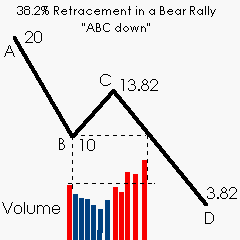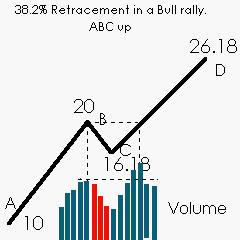Overview
Fibonacci numbers are the result of work by Leonardo Fibonacci in the early 1200's while studying the Great Pyramid of Gizeh. The fibonacci series is a numerical sequence comprised of adding the previous numbers together, i.e.,
(1,2,3,5,8,13,21,34,55,89,144,233 etc..)
An interesting property of these numbers is that as the series proceeds, any given number is 1.618 times the preceding number and 0.618% of the next number.
(34/55 = 55/89 = 144/233 =0.618) (55/34 =89/55 =233/144 =1.618), and 1.618 =1/0.618.
This properties of the fibonacci series occur throughout nature, science and math and is the number 0.618 is often referred to as the "golden ratio" as it is the root of the following polynomial x^2+x-1=0 which can be rearranged to x= 1/(1+x).
So that's were the fib # 0.618 comes from. The other fibs 0.382 and 0.5 commonly used in technical analysis have a less impressive background but are just as powerful in Technical analysis.
0.382=(1-.618)=(0.618*0.618)
and 0.5 is the mean of the two numbers.
Other neat fib facts (0.618*(1+0.618)=1 and (0.382*(1+.618))=0.618.
Use of Fibonacci #'s in Technical Analysis
Fibonacci numbers are commonly used in Technical Analysis with or without a knowledge of Elliot wave analysis to determine potential support, resistance, and price objectives. 38.2% retracements usually imply that the prior trend will continue, 61.8% retracements imply a new trend is establishing itself. A 50% retracement implies indecision. 38.2% retracements are considered nautral retracements in a healthy trend.
ABC's
Price objectives for a natural retracement (38.2%) can be determined by adding (or subtracting in a downtrend) the magnitude of the previous trend to the 38.2% retracement. After the 38.2% retracement the stock should break through the previous swing point(B) on heavier volume. If the volume isn't there the magnitude of the move will usually be diminished, especially on very low volume.
A-B =C-D when B-C =38.2% of A-B
61.8% retracements are warning signs of a potential trend changes. For a more detailed explanation of Fibonacci price projections and price wave theory I highly recommend the Elliot Wave Principle links below.
Confluence Confluence occurs when you take fibonacci projections off of multiple trends and get the same number and strengthens when it corresponds with other technical advents such as gaps, swing high/lows, chart indicators crossovers (MACD, RSI, Stochastics, etc.), trading congestion, etc. The more confluence, the more significant the level. I really take notice when I get two or more fib #s (say a 38.2% and 61.8%) to correspond with a gap in the chart or a swing high. Confluence is very powerful as it combines multiple technical analysis techniques to arrive at the same conclusion, and should be relied on accordingly IMHO
Trading Strageties JMHO
Once a new swing point is established in an equity, a new set of fibonacci numbers should be calculated, and confluence checked to determine potential support/resistance levels and trading strategies. (let the Fibonacci Calculator do most of the work for you). For instance:
If a stock is trending up, one may watch it until it forms a top then calculate the fibs. If she retraces 38.2% and turns with confluence, one could bite with an automatic stop under the 50% retracement and objective of the ABC. The Risk/Reward ratio for that trade is 0.118. (If you got stopped out 8 times and hit once you would have a 5.6% profit).
If she's trending down, you could bite at the 38.2% bounce with a stop at the 50% and get the same risk/reward ratio. With both strategies it is critical for the volume to be heavier on the swing point breakout.
If a position is going with you and you're looking for an exit point, calculate the 38.2% fib once a top is clear and put a stop below it. Won't get you out at the top but you may not miss that monster rally either.
Think a stock is a dog but it's trading at it's high wait for a 61.8% retracement from the last trend and sell it, with the stop below the 50% retracement.
Subscribe to:
Post Comments (Atom)
My Blog List
Total Pageviews
Search This Blog
Followers
Blog Archive
-
▼
2012
(37)
-
▼
January
(18)
- Fibonacci Numbers
- Bob-Marley-The-Wailers-Get-Up-Stand-Up My favorite...
- Buying Stocks When The Price Goes Down: Big Mistake?
- COG CHART
- AFL COG
- LINKS
- http://www.stockta.com/fibonacci.html ...
- Website Links
- For Rakib Vai
- INTRA BP SP
- FIBO RETS EXTEN COMENTRY NICE AFL
- No title
- SIMPLE MA CROSSOVER AFL SCAN
- Stock Scanning /Shortlisting
- Remember it
- DSE EOD DOWNLOAD
- DSE bull
- Linear Regression Channel with Trend Identifier fo...
-
▼
January
(18)


No comments:
Post a Comment